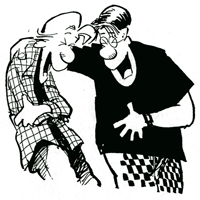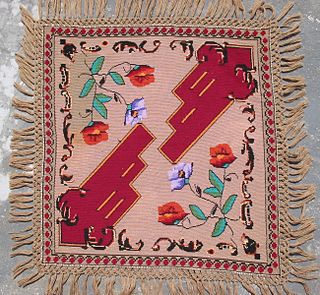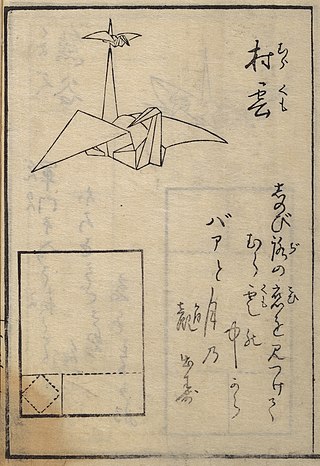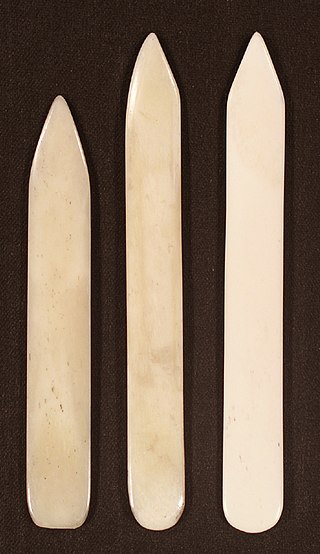
Origami is the Japanese art of paper folding. In modern usage, the word "origami" is often used as an inclusive term for all folding practices, regardless of their culture of origin. The goal is to transform a flat square sheet of paper into a finished sculpture through folding and sculpting techniques. Modern origami practitioners generally discourage the use of cuts, glue, or markings on the paper. Origami folders often use the Japanese word kirigami to refer to designs which use cuts.

A towel is a piece of absorbent cloth or paper used for drying or wiping a surface. Towels draw moisture through direct contact.

The discipline of origami or paper folding has received a considerable amount of mathematical study. Fields of interest include a given paper model's flat-foldability, and the use of paper folds to solve up-to cubic mathematical equations.

Makiyakinabe are square or rectangular cooking pans used to make Japanese-style rolled omelettes. The pans are commonly made from metals such as copper and tin, and can also be coated with a non-stick surface. Dimensions and proportions of the pan vary among regions of Japan, but it is always rectangular. Rolled omelettes made with makiyakinabe are commonly used as a side dish in sushi and bentō.

Zits is a comic strip written by cartoonist Jerry Scott and illustrated by Jim Borgman about the life of Jeremy Duncan, a 17-year-old high school junior. The comic debuted in July 1997 in over 200 newspapers and has since become popular worldwide and received multiple awards. As of 2010, it continues to be syndicated by King Features and is now included in "more than 1,700 newspapers worldwide in 45 countries and is translated into 15 different languages."

Rose Is Rose is a syndicated comic strip, written by Pat Brady since its launch on April 16, 1984, and drawn since March 2004 by Don Wimmer. The strip revolves around Rose and Jimbo Gumbo, their son Pasquale, and the family cat Peekaboo. Rose and Jimbo are deeply in love with each other, sometimes exchanging love notes or kissing under the stars, and they dote fondly on Pasquale.
Anne Elizabeth Geddes is an Australian-born, New York City-based portrait photographer known primarily for her elaborately-staged photographs of infants.

Robert J. Lang is an American physicist who is also one of the foremost origami artists and theorists in the world. He is known for his complex and elegant designs, most notably of insects and animals. He has studied the mathematics of origami and used computers to study the theories behind origami. He has made great advances in making real-world applications of origami to engineering problems.

A tablecloth is a cloth used to cover a table. Some are mainly ornamental coverings, which may also help protect the table from scratches and stains. Other tablecloths are designed to be spread on a dining table before laying out tableware and food. Some tablecloths are designed as part of an overall table setting, with coordinating napkins, placemats, or other decorative pieces. Special kinds of tablecloth include "runners" which overhang the table at two ends only and "table protectors" which provide a padded layer under a normal tablecloth.

Akira Yoshizawa was a Japanese origamist, considered to be the grandmaster of origami. He is credited with raising origami from a craft to a living art. According to his own estimation made in 1989, he created more than 50,000 models, of which only a few hundred designs were presented as diagrams in his 18 books. Yoshizawa acted as an international cultural ambassador for Japan throughout his career. In 1983, Emperor Hirohito awarded him the Order of the Rising Sun, 5th class, one of the highest honors bestowed in Japan.

A fortune teller is a form of origami used in children's games. Parts of the fortune teller are labelled with colors or numbers that serve as options for a player to choose from, and on the inside are eight flaps, each concealing a message. The person operating the fortune teller manipulates the device based on the choices made by the player, and finally one of the hidden messages is revealed. These messages may purport to answer questions or they may be activities that the player must perform.

A towel animal is a depiction of an animal created by folding small towels. It is conceptually similar to origami, but uses towels rather than paper. Some common towel animals are elephants, snakes, rabbits and swans.

A napkin holder is a device used to hold napkins. A napkin holder can be made from virtually any solid material and is built so that the napkins do not slip from its hold, either by way of sandwiching them between two surfaces, or simply enclosing them on their sides in a horizontal design. Napkin holders range in price and styles from wooden designs to wrought iron or ceramic styles and many others. One iteration of the napkin holder, better known as a napkin dispenser, offers additional functionality with its design: folded napkins are enclosed in a snug metal casing, allowing users to retrieve a single napkin each time they reach into the container; this particular device is usually found in restaurants, diners, and other public eateries, while its simpler—often more aesthetically pleasing—counterpart, the holder, is common to households and classrooms. There is also an item which holds a napkin or serviette in a button hole or the top of a conventional necktie knot. It is conjectured as a clamp for the corner of a napkin and an hook which hooks into the top of the tie knot. They are most usually in sterling silver and date back to at least Edwardian times. Hence often to be found in antique outlets as functional collectors items. Certain "gentleman's clubs" include a button hole in a corner of their napkins for direct coupling to an upper shirt button.
Kunihiko Kasahara is a Japanese origami master. He has made more than a hundred origami models, from simple lion masks to complex modular origami, such as a small stellated dodecahedron. He does not specialize in what is known as "super complex origami", but rather he likes making simple, elegant animals, and modular designs such as polyhedra, as well as exploring the mathematics and geometry of origami. A book expressing both approaches is Origami for the Connoisseur, which gathers modern innovations in polyhedral construction, featuring moderately difficult but accessible methods for producing the Platonic solids from single sheets, and much more.

The history of origami followed after the invention of paper and was a result of paper's use in society. In the detailed Japanese classification, origami is divided into stylized ceremonial origami and recreational origami, and only recreational origami is generally recognized as origami. However, this page describes the history of both ceremonial and recreational origami.

A bone folder, bonefolder, or folding bone is a dull-edged hand tool used to fold and crease material in crafts such as bookbinding, cardmaking, origami, and other paper crafts that require a sharp crease or fold. The tool was also used when correspondence by letter writing was more formal and an art.
Lillian Rose Vorhaus Kruskal Oppenheimer was an American origami pioneer. She popularized origami in the West starting in the 1950s, and is credited with popularizing the Japanese term origami in English-speaking circles, which gradually supplanted the literal translation paper folding that had been used earlier. In the 1960s she co-wrote several popular books on origami with Shari Lewis.
The napkin folding problem is a problem in geometry and the mathematics of paper folding that explores whether folding a square or a rectangular napkin can increase its perimeter. The problem is known under several names, including the Margulis napkin problem, suggesting it is due to Grigory Margulis, and the Arnold's rouble problem referring to Vladimir Arnold and the folding of a Russian ruble bank note. Some versions of the problem were solved by Robert J. Lang, Svetlana Krat, Alexey S. Tarasov, and Ivan Yaschenko. One form of the problem remains open.

Hotel toilet paper folding is a common practice performed by hotels worldwide as a way of assuring guests that the bathroom has been cleaned.

Napkin folding is a type of decorative folding done with a napkin. It can be done as art or as a hobby. Napkin folding is most commonly encountered as a table decoration in fancy restaurants. Typically, and for best results, a clean, pressed, and starched square cloth napkin is used. There are variations in napkin folding in which a rectangular napkin, a napkin ring, a glass, or multiple napkins may be used.

















